Welcome to my Apeman A80 review!
Today I will talk about the Apeman A80 action camera which was released back in 2018.
Now to be truthful, I always think of GoPro when it comes to action cameras since they are the leader in the action camera market.
But we all know that GoPro cameras don’t come at a cheap price.
There are a lot of great alternatives that are much cheaper. Some are good quality and some other that aren’t and those can never compete with GoPro.
Do you think the Apeman A80 will be able to go against the GoPro?
Le’s discover that through my below review, where I will try to give you as much detail as possible starting from what’s in the box then talking about the specs, settings, video, photo, audio and app.
Let’s start with the specs then the un-boxing!
Let’s Jump to the Review!
Product: Apeman A80 2018
My rating: 4.3/5
Price: $
Cheapest place to buy: Amazon.com
Specs (from Apeman’s website)
Screen (LCD): 2.0 inch
Video Resolution: 4K 24fps/ 2k 30fps/ 1080P 60fps/ 1080P 30fps/ 720P 120fps/ 720P 60fps & more.
Sensor: Sony IMX078 Sensor
Visual Angles: 170°/140°/110°/70°
Image Resolution: 20M/ 16M/ 12M/ 10M/ 8M/ 5M/ 3M/ VGA
Storage: micro SD up to 128GB
Shooting Mode: Single Shot / Self-timer (2S / 5s / 10s / Double)
Time-lapse Record: 100ms / 200ms / 500ms / 1Sec / 5 Sec
Battery Capacity: 3.7V Li-ion Battery 1050 mAh (Two Batteries Included )
What’s in the Box?
The camera comes in a hard zip up case with a carry handle. Everything fits nicely and neatly in this case, it’s really good for travelling.
You have a user manual, a micro USB charging cable, two 1050mAh
batteries which gives around 120 minutes of video recording per battery.
You get a few accessories, a user manual and a cleaning cloth. Note that there is no remote control included with the camera.
The A80 has a waterproof case that can be used down to 30 meters underwater.
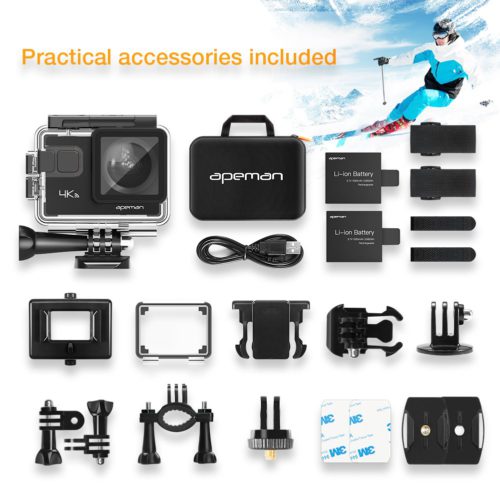
Design
Front
At the front, you got the 170 degree wide angle lens which is adjustable in the camera’s settings. You can adjust the field of view angle down to 70 degrees.
The lens aperture is f/1.8.
Apeman claims that the A80 can shoot 4K videos at 24 frames per second and can take 20 megapixels photos.
You also have the power button that is used to turn the camera On and Off, and also used as a Mode button to change between shooting modes (video, photo, playback and settings).
The Apeman A80 comes with the Sony IMX078 sensor and a Novatek 96660 Chipset.
The sensor and chipset are the same as the ones used in the previous Apeman A77 model.
At the Back
On the back, there is a 2.0inch LCD screen which is not touchscreen and you will need to use the navigational buttons on the side.
At the Top
There is a shutter button that also serves as an OK button (Enter button) and a shutter light.
At the Side
You have a micro SD card slot, a micro USB port for charging and a mini HDMI port to output to a large monitor/TV or to capture videos using a capture device.
At the Bottom
At the bottom, there is the battery compartment.
At the Other Side
There two buttons that serve as navigation buttons, up and down. You use them to control the menu settings of the camera.
There is also a WiFi button. So you can actually remotely record.
Video
Video Resolutions
The Apeman A80 claims that it can record 4K videos. However, the built-in chipset and the SONY image sensor is only capable of shooting videos of up to 2K.
Which means that the 4K that the camera is not a native 4K, but more of an interpolated 4K.
Know the difference between native and interpolated 4K here.
It’s a bit unfortunate to be honest, but remember that it’s a camera that costs less than 80$!
The video resolutions start from the highest:
- Interpolated 4K (2880 x 2160)
- 2K (2048×1080)
- 1080p (1920×1080)
- 720p (1280×720)
- WVGA (768×480)
- VGA (640×480)
- QVGA (320×240)
I honestly have no idea why they have an option for these low resolutions below 720p.
4K, 2K, 1080p and 720p have a aspect ratio of 16:9 (wide screen). WVGA is also wide screen with an aspect ratio of 16:10.
And the rest like VGA and QVGA have an aspect ratio of 4:3.
Frame Rates
Frame rate is the number of frames the camera captures in one second of video.
Due to the sensor size, the A80 can shoot a maximum of 120 frames per second and only with the 720p resolution.
And 240 fps with the WideVGA resolution which is useless in my opinion. Why would anyone use a resolution below 720p these days?
60 frames per second is available with the 720p and 1080p.
30 frames per second is available with the 2k and 1080p.
24 frames per second is available with the interpolated 4k.
Codec
The Apeman A80 uses the H264 codec to compress the videos and save them in .MP4 format.
H264 or AVC (Advanced Video Coding) processes and lowers bitrates which compresses the videos so they take less space on your micro SD card.
H264 is much better than previous and older video encoders in processing and compressing videos.
However, you can get higher and better compression with the H265 (HEVC) which is not available on this camera.
Slow-Motion
The A80 can shoot slow motion videos thanks to the 120 frames per second captured with the 720p resolution and the 240 fps on the WVGA.
With 120 frames per second, you can slow your videos 4 times, with the 240 frames per second, 8 times and with the 60 frames per second, 2 times.
For best slow motion results, I would advise you to use the 720p with the 120fps along with the image stabilization option (gyroscope) to get the best stable footage.
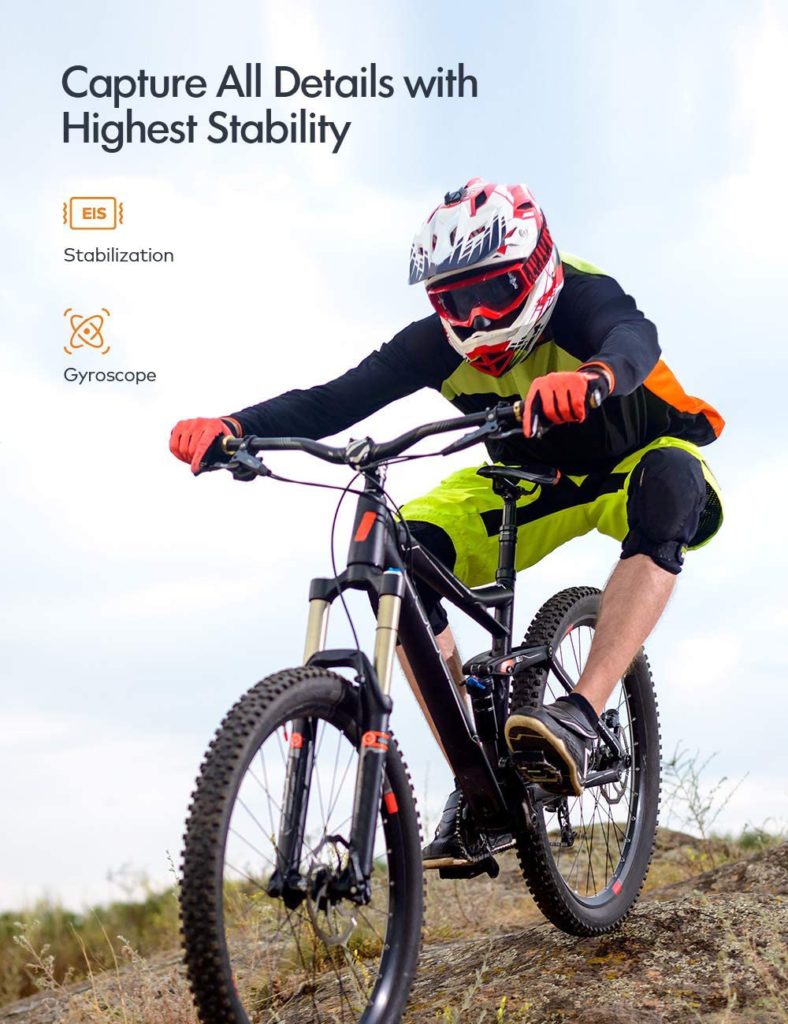
I personally wouldn’t use the slow motion with the WVGA resolution due to the low video quality.
The WVGA videos will look pixelated on a full HD TV so imagine how it would look on a 4K TV or monitor.
Bitrate
The A80 has a maximum bitrate of 24Mb/s (megabits per second) when used in the interpolated 4k resolution.
If you don’t know, the real 4k resolution needs much higher bitrate in the range of 35 to 40Mb/s.
Another reason why this camera cannot shoot in real 4k.
Stabilization
Gyroscope on the Apeman A80 also known as EIS (Electronic Image Stabilization) and is used to stabilize the video to make it smoother and less jittery.
Image Stabilization and anti-shake are great on this camera and they really do work with the 1080p resolution.

I think this is my favorite feature on the A80 and it does give it a great advantage.
The gyroscope will work with all video resolutions up to 1080p at 60 fps.
EIS is not available with the 4K and 2K resolutions, so if you turn the gyroscope on while in the UHD 4K resolution, the camera will turn it off automatically.
FOV
FOV or Field of View is what defines the angle the camera will shoot.
So the higher the FOV the bigger the shooting angle.
The standard angle on the A80 is 170 degrees but you can also set it to 140, 110 and 70.
Loop Recording
Continuous video recording or loop recording is supported on this camera.
You can set it to 3 minutes, 5 minutes or 10 minutes.
In this mode, the camera will take continuous video but will only save the last 3, 5 or 10 minutes. Depends which setting you choose.
Video Quality
The video quality is crisp and clear during daytime recording. So it is definitely better than the other cheap Chinese cameras you can find at a similar price.
Maybe it weren’t for so much fish-eye, I would have say that yeah it looks a bit better.
I don’t think it does the greatest with dynamic range, it had a hard time finding the right level of brightness, details in the shadows.
The fish-eye is a 170 degree angle, some can find it too much, but remember that this is an action camera so wide angle is expected.
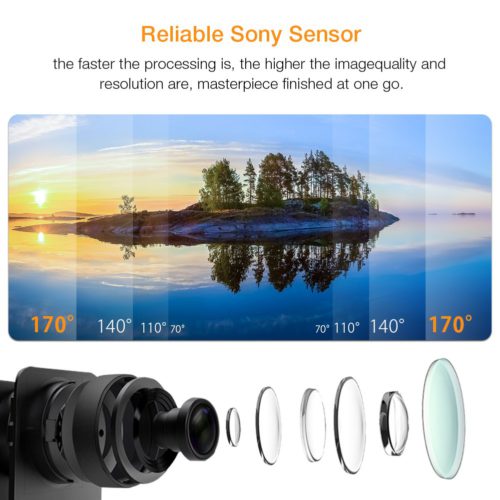
Night time recordings are not as good as day time recordings due to the limitation of the lens sensor.
Photo
Photo Resolution
The Apeman A80 can take photos with up to 20 megapixels. But you can also choose lower resolutions like 18, 16, 12, 10, 8, 5, 3 and VGA.
Like the video resolutions, using the low photo resolutions like 5, 3 and VGA is useless.
The photos are shot with the widest Field of View angle at 170 degrees.
All photos are saved on the micro SD card using the JPEG format. No other formats are available on this camera.
Burst
The A80 has the burst option which takes a sequence of still photos in a very short time.
It can capture 3 photos in 1 second. This option can be selected under the photo settings.
Photo Quality
The photos turn out quite well when shooting with a lot of light, way better than expected especially when enabling WDR.
However, night photos are not the best unfortunately even with night mode ON.
But that is expected from most of the action cameras especially the cheap ones.
This is also due to some limitations in both the image sensor and the chipset.
Time-Lapse
The Apeman A80 can only shoot video time lapse, no photo time lapse on this camera.
In a video time lapse, the camera captures frames as per the specified time intervals and then combine them in one video file.
On the A80, you have different interval rates: 100ms (millisecond), 200ms, 500ms, 1sec and 5sec.
Video time lapses are a nice addition but I would avoid shooting in low-light with the A80.
Audio
When it comes to the audio on the Apeman A80, I must say I wasn’t very impressed.
There is only one microphone located at the top of the camera.
The audio is a bit loud in videos and can get noisy very easily, since there is no wind-noise reduction feature in the camera.
Settings and Features
I can go the camera’s settings menu by clicking the front power button once.
In the menu, you will see different tabs:
1- Resolution: for specifying the resolution you want to use for shooting video footage.
2- Loop recording: that enables you to record footage continuously without interruption.
3- Gyroscope or image stabilization.
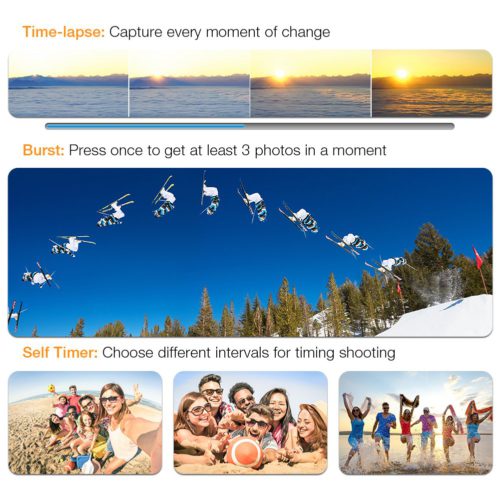
4- Time-lapse Record: To record videos at intervals then play it back at a faster speed. Good for capturing a sunset, sunrise, clouds, etc..
Then you have the rest of the settings like WDR, Driving Mode, Night Scene, Self Timer, Image Size, Quality, Sharpness, Motion Detection, Record Audio, Data Stamp, White Balance, Color, ISO, EV Exposure Value, WiFi.
As you can see, you have quite a few options in the A80 which is nice and it makes it compatible with different shooting times, like shooting during the day or in the night.
Also in different situations like shooting moving objects, extreme sports activities or simply just walking around with the camera.
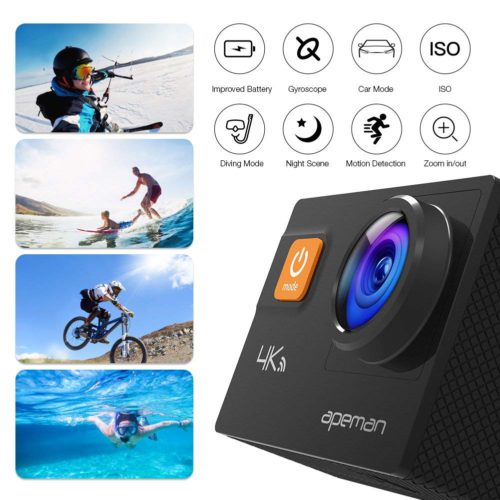
App/WiFi
The A80 can also broadcast WiFi which enables you to connect your smartphone to the camera using the Apeman app called ZSANYCAM.
This app is available for download from both the App store and Google play store.
Once you install the app, you need to turn on the WiFi network from the camera by pressing the Up button located on the right side of the camera.
As soon as the camera is connected, you can see everything you camera sees.
From the app, you can fully control the camera. You can take photos, videos, change modes and settings. You can also playback videos and check the photos you just took.
Lastly, you can share your footage to social media channels directly from the app so this is another cool thing you can do with the camera.

Battery
Apeman claims that the battery can last up to 180 minutes but unfortunately the battery life is a lot shorter.
I was able to get around 90 minutes of use before the battery died. I guess that is the reason they included a second battery in the box.
When shooting in 4K, the battery won’t last more than 60 minutes. In 2K, around 70 minutes and 90 minutes in 1080p.
Charging the battery takes around 3 hours so better to have more than 2 batteries if there is plan to shoot for a couple of hours.
Memory Card
The memory card is where all your videos and photos are saved.
It should be bought separately as like all other action cameras, it is not included in the box.
Apeman recommends a class 10 memory card with up to 64GB (this is the maximum size supported by the camera).
Make sure to format the SD card using the camera, you can find the format option in the settings.
When you first insert the new micro SD card, you will see a message that the card is not supported but it will disappear once you format the card.
Other Usage
Due to the fact that the A80 can be used while being charged, and with the availability of the micro USB and mini HDMI ports, this gives it more usage than just an action camera.
The A80 can be used for streaming and recording YouTube videos. It can also be used as a dash cam, security cam or even a webcam.
When in dash cam mode, the camera will start recording as soon the car engine starts. Of course, the A80 should be connected to the 5V charger of your car.
Another cool idea is to use it with a gimbal like the Zhiyun Smooth 4, that way you can record with 4K without worrying about the stabilization since the gimbal will take care of that.
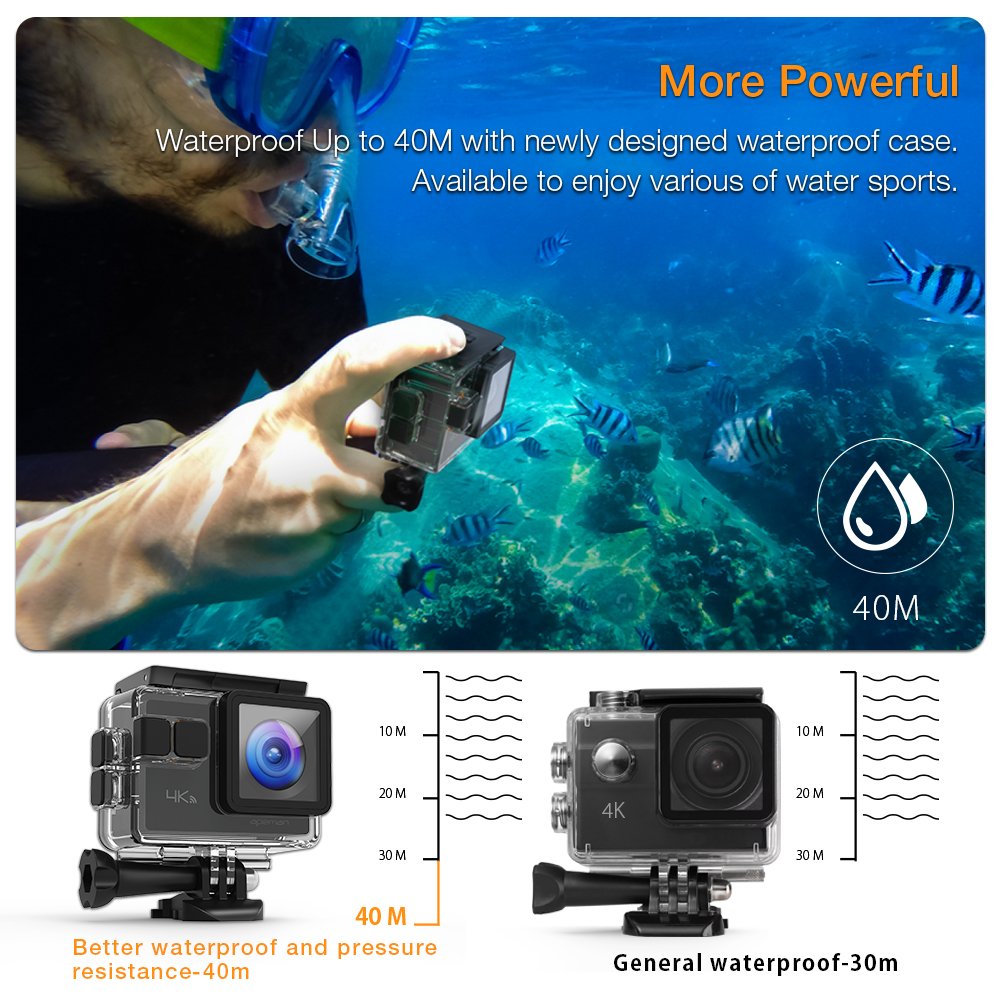
Here’s a video by Chigz Tech Reviews showing video and photo samples from the Apeman A80:
To Conclude
Overall, the Apeman A80 is a good camera. It doesn’t have a real 4K resolution due to the chipset, it does interpolated 4K instead.
But it does perform well when taking videos with 1080p and using EIS, so clear video and loud audio.
It’s not great in low light and the Electronic Image Stabilization is not available in 4K and 2K.
Photo quality is good but definitely less than 20 Megapixels as Apeman claims so probably photos are also interpolated.
It is definitely not a GoPro or even close to one. But if you like the brand, you can look at the Apeman A100 which is more powerful than the A80.
Nevertheless, for its price, it is certainly a bargain.
It is fair for what you are getting especially that it comes with 2 batteries, a nice travelling case and a bunch of accessories so you don’t have to spend more money.
I liked this camera but it will be up to you to decide whether you will invest in one.
I hope you enjoyed my Apeman A80 review and found it useful!
If you have any questions then please don’t hesitate to leave a comment in the comments section below and I will be more than happy to answer your questions 🙂







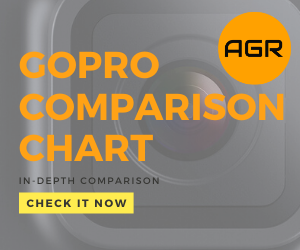
Leave a Reply